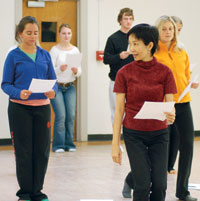Growing up in Taiwan, Yunyu Wang was told that dancing would lead to poverty, unemployment, and loneliness. Yet dance has brought her recognition, a professorship at Colorado College, and most recently a $1.5 million grant from Taiwan’s Ministry of Economic Affairs.
The grant merges science and art to produce a unique computer software program that will benefit three realms: animated entertainment, rehabilitation and fitness (especially for the elderly), and the performing arts. The resulting software will enable dancers, physical therapists, and other professionals to analyze movement beyond visual observation. Wang will use her expertise to help “translate” moves such as jetés into a systematized formula. The results will document how the body can express emotion or avoid injury.
Animation programmers approached Wang three years ago about a collaborative project while she was in China setting up the CC Biology-in-China program and presenting a workshop on Labanotation. Wang is certified in both Labanotation and Laban Movement Analysis (LMA), two ways to notate and interpret movement based on the work of European dance theorist Rudolf Laban. Labanotation uses symbols to record the dynamics of a dancer’s movement; LMA draws upon theory to describe and interpret movement through body, effort, shape, and space.
Patrizia Herminjard ’96, who teaches dance part time at CC, describes Labanotation as a way to capture nuances of movement, which are not caught on video. “Why does movement ‘read’ the way it does?” Herminjard asks. “What does the body have to say in order for it to be seen as sad?”
By articulating her knowledge, Wang can answer questions like these to become the interpreter between the human body and technology. Computer programming experts will take the minute details of a hand flourish or a pointed toe and turn them into computer language. “If I can say the movement clearly, say it rather than just feel it,” Wang explains, “then the computer programmers believe they can systemize that.”
Once computerized, movement software will benefit professionals such as animators, physical therapists, and performing artists, as they use it to communicate human movement in great detail. No such software currently exists, so Wang believes the project will push beyond research to return a profit. While Wang’s team will retain their product’s copyright, Taiwan will gain credit for supporting an innovative product that businesses throughout the world will purchase.
CC students will benefit as well. Taipei National University of the Arts (TNUA), a sponsor of the project, established a lab with cutting-edge equipment needed for this undertaking. CC students who participate in the Biology-in-China exchange program led by Wang have access to these resources.
No longer “a young faculty member who can jump up and down,” Wang recognizes that her greatest value to students is her continued growth as a professional. “If I can make myself more advanced through this project, then my students will benefit… If I don’t continue my research, then I will become old in my teaching and bore my students.”
Boring hardly describes this tenacious woman, who applied for the grant 10 times over three years. Wang’s hard work is just beginning, as she and her team have three more years to start spinning movement into a marketable computer program.
Other current CC grants reveal some of the diverse interests and needs of a vibrant campus:
Colorado?s State Historical Fund awarded a $150,000 grant to CC to replace the roof and repair masonry on the Spencer Center, listed on the National Register of Historic Places in 1983.
The Teagle Foundation gave Colorado College, Kalamazoo College, and Earlham College $300,000 (to be divided equally) to fund a collaborative project designed to assess students in order to identify the expected results of a liberal arts education, including critical thinking, analysis, and writing.

